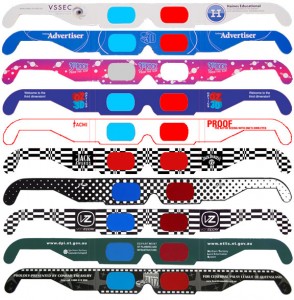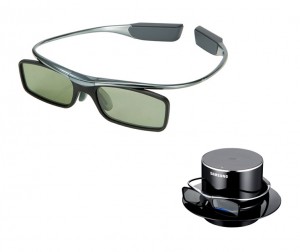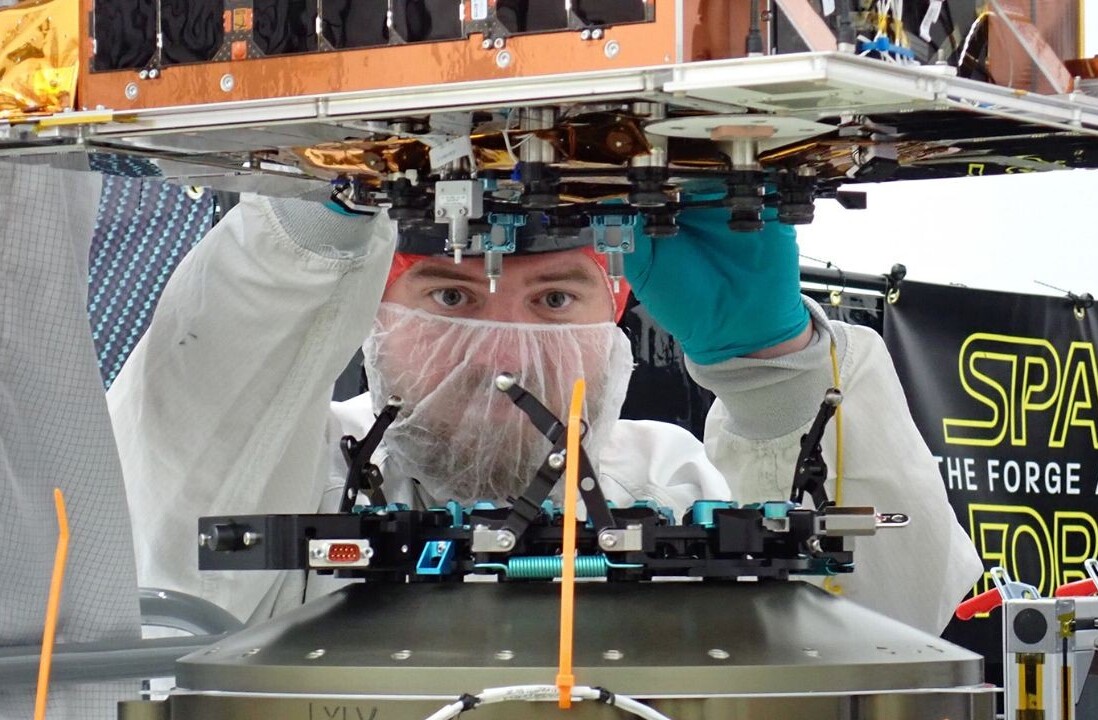
 Two weeks ago at CES, the world got a preview of the latest and greatest in 3D technology. One of the hottest topics was the future of 3D television, especially since the major players in the industry are divided over the question of active vs. passive.
Two weeks ago at CES, the world got a preview of the latest and greatest in 3D technology. One of the hottest topics was the future of 3D television, especially since the major players in the industry are divided over the question of active vs. passive.
In active 3D, the display rapidly alternates between the left-eye and the right-eye image in the same space, usually at about twice the frame-rate necessary for continuity of motion (120Hz). Active 3D glasses have lenses which turn from opaque to transparent in perfect sync with the transformation of the image.
Passive 3D is thought better for large groups since the expensive technology is primarily in the display rather than each pair of glasses. Passive 3D projects an image to the left eye and the right eye simultaneously and into the same space, and then relies on a special set of glasses to show each image to its intended eye while blocking out the unintended image from that eye.
While Sony, Panasonic and Sharp stuck with active-shutter technology, LG and Vizio introduced new televisions that work with passive glasses. There were also the expected “wow” concepts, like LG’s prototype of a mobile device that lets users watch 3D without glasses.
But let’s face it – even though we’ve come a long way from white paper frames filled with red and blue cellophane panels, traditional 3D glasses do not exactly look “cool.” So until glasses-free 3D becomes a practical reality, here are a few alternatives that let consumers watch 3D television in four-eyed style.
PASSIVE GLASSES
Oakley 3D Gascan
 Oakley’s passive 3D Gascan glasses are as cool and sophisticated as the company’s signature shades. In fact, when I accidentally wore my review model instead of my sunglasses, I had two different people stop me on the street to ask me where they could buy a pair. (Although they do have UV protection, they don’t really do much to block sunlight, so it’s probably best to limit use to 3D viewing experiences.) It’s a natural brand extension for a company that’s known for focusing on high quality optics, and the 3D eyewear is no exception. Marketed as the first “optically correct” glasses, the hard lenses wrap around the viewer’s head for better peripheral vision, and incorporate the company’s proprietary HDO-3D™ technology for increased visual clarity. Of course, these designer 3D glasses come complete with a designer price tag. The white and black styles retail for $120, while the “TRON” limited edition is sold for $150.
Oakley’s passive 3D Gascan glasses are as cool and sophisticated as the company’s signature shades. In fact, when I accidentally wore my review model instead of my sunglasses, I had two different people stop me on the street to ask me where they could buy a pair. (Although they do have UV protection, they don’t really do much to block sunlight, so it’s probably best to limit use to 3D viewing experiences.) It’s a natural brand extension for a company that’s known for focusing on high quality optics, and the 3D eyewear is no exception. Marketed as the first “optically correct” glasses, the hard lenses wrap around the viewer’s head for better peripheral vision, and incorporate the company’s proprietary HDO-3D™ technology for increased visual clarity. Of course, these designer 3D glasses come complete with a designer price tag. The white and black styles retail for $120, while the “TRON” limited edition is sold for $150.
Look3D
 Want to rock some Shrek 3D glasses, complete with ogre ears? Or maybe a pair of chic black oversized frames with gunmetal trim? Look3D is an Australian-based company that designs a wide array of fun, funky and fashionable passive 3D glasses for any screen that uses RealD 3D technology. Their online store carries over 40 styles, and look out for the Pirates of the Caribbean 4 models that are due out in the next few months. Plus, Look3D has some of the most affordable 3D passive glasses on the market: the Movie Collection starts as low as $11 and the Designer Collection is priced between $25 and $30. And for those real connoisseurs willing to spend a little extra, the Director Collection features handmade acetate frames for $60 to $80.
Want to rock some Shrek 3D glasses, complete with ogre ears? Or maybe a pair of chic black oversized frames with gunmetal trim? Look3D is an Australian-based company that designs a wide array of fun, funky and fashionable passive 3D glasses for any screen that uses RealD 3D technology. Their online store carries over 40 styles, and look out for the Pirates of the Caribbean 4 models that are due out in the next few months. Plus, Look3D has some of the most affordable 3D passive glasses on the market: the Movie Collection starts as low as $11 and the Designer Collection is priced between $25 and $30. And for those real connoisseurs willing to spend a little extra, the Director Collection features handmade acetate frames for $60 to $80.
Marchon3d EX3D
 The new EX3D line of passive glasses from Marchon is like Honda Civic of 3D eyewear: classic, conservative and affordable. Expected to arrive in stores this spring, the collection retails from $30 to $35, and features a variety of standard color and frame choices in different sizes for men, women and children. All of the glasses will use Marchon’s new patented curved lens technology, which improves the viewing experience by reducing peripheral distractions like light contamination and haze. And since the lenses are designed to function with movie theater screens and passive technology video game consoles as well as passive 3D televisions and laptops, users can seamlessly transition between entertainment options without changing glasses.
The new EX3D line of passive glasses from Marchon is like Honda Civic of 3D eyewear: classic, conservative and affordable. Expected to arrive in stores this spring, the collection retails from $30 to $35, and features a variety of standard color and frame choices in different sizes for men, women and children. All of the glasses will use Marchon’s new patented curved lens technology, which improves the viewing experience by reducing peripheral distractions like light contamination and haze. And since the lenses are designed to function with movie theater screens and passive technology video game consoles as well as passive 3D televisions and laptops, users can seamlessly transition between entertainment options without changing glasses.
ACTIVE GLASSES
XPAND YOUNIVERSAL
 Going beyond color and frame choices, XPAND plans to offer the ultimate in personalization with their active-shutter 3D glasses that allow the actual 3D parameters, such as transition speed, to be adjusted for individual viewing optimization. The YOUNIVERSAL series, which will be compatible with all major brands of 3D TVs, works with an accompanying app for iPhone and Android that lets users customize the glasses for best use with their specific facial structure, viewing position and eyesight. Other features include a rechargeable battery and integrated USB port. The glasses are designed by Gigodesign studio, and are available in red, black and gray. They will start shipping in April 2011, and although the company has yet to comment on the price, it’s expected to be on the high end, especially since regular XPAND eyewear retails for around $130.
Going beyond color and frame choices, XPAND plans to offer the ultimate in personalization with their active-shutter 3D glasses that allow the actual 3D parameters, such as transition speed, to be adjusted for individual viewing optimization. The YOUNIVERSAL series, which will be compatible with all major brands of 3D TVs, works with an accompanying app for iPhone and Android that lets users customize the glasses for best use with their specific facial structure, viewing position and eyesight. Other features include a rechargeable battery and integrated USB port. The glasses are designed by Gigodesign studio, and are available in red, black and gray. They will start shipping in April 2011, and although the company has yet to comment on the price, it’s expected to be on the high end, especially since regular XPAND eyewear retails for around $130.
Samsung SSG-3700CR
 Samsung unveiled a pair of super-light active-shutter 3D glasses that weigh only 28 grams and have a unique wrap-around design. Developed in partnership with the Austrian firm Silhouette, the eyewear is innovative because all of the electronic components are housed in the rear of the frame, exactly dividing the center of gravity between the front and the back and reducing the weight on the nose. The glasses automatically turn on when 3D content is being displayed and work with a special wireless charging stand that users can simply place the glasses on to charge. Prices for the glasses and charging system have not been released, although both are expected within the first half of 2011.
Samsung unveiled a pair of super-light active-shutter 3D glasses that weigh only 28 grams and have a unique wrap-around design. Developed in partnership with the Austrian firm Silhouette, the eyewear is innovative because all of the electronic components are housed in the rear of the frame, exactly dividing the center of gravity between the front and the back and reducing the weight on the nose. The glasses automatically turn on when 3D content is being displayed and work with a special wireless charging stand that users can simply place the glasses on to charge. Prices for the glasses and charging system have not been released, although both are expected within the first half of 2011.
ACTIVE + PASSIVE GLASSES
Volfoni Activeyes
 Volfoni used CES to showcase “hybrid” 3D glasses, a new product line called Activeyes that allows users to switch between active and passive modes. Designed with square black frames, the Activeyes glasses look like they were once owned by Buddy Holly, making them the perfect choice for hipsters. The system is made up of two parts: a pair of passive glasses that weigh only 29 grams, and a clip-on attachment that holds the electronic guts necessary to power the active shutter mode. The glasses also have different levels of UV protection that can be adjusted by the user. According to Volfoni, they are “the world’s first totally universal eyewear, compatible with all active and passive 3DTVs and PC monitors currently available on the market.” The Activeyes system will be available in March 2011, and will retail for under $100.
Volfoni used CES to showcase “hybrid” 3D glasses, a new product line called Activeyes that allows users to switch between active and passive modes. Designed with square black frames, the Activeyes glasses look like they were once owned by Buddy Holly, making them the perfect choice for hipsters. The system is made up of two parts: a pair of passive glasses that weigh only 29 grams, and a clip-on attachment that holds the electronic guts necessary to power the active shutter mode. The glasses also have different levels of UV protection that can be adjusted by the user. According to Volfoni, they are “the world’s first totally universal eyewear, compatible with all active and passive 3DTVs and PC monitors currently available on the market.” The Activeyes system will be available in March 2011, and will retail for under $100.
Which 3D glasses are your favorite?
Get the TNW newsletter
Get the most important tech news in your inbox each week.




